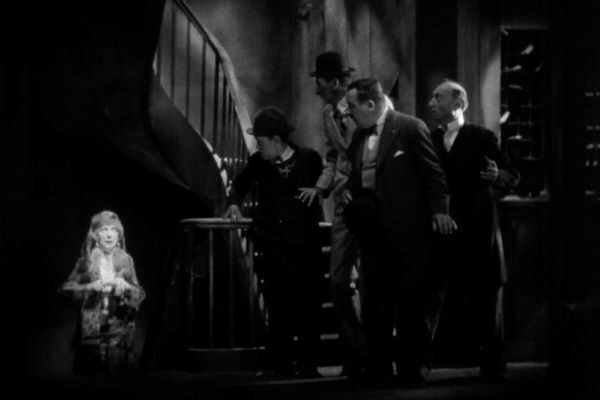One of the last big silent productions from Universal Studios (although a ‘halfway’ version containing various sound effects is long lost), The Last Warning is also notable as the final film of Paul Leni, prior to his early death from complications of an abscessed tooth. Perhaps the most obscure of the émigré silent greats from Germany and Austria, Leni has never achieved the respect that F.W Murnau and Fritz Lang have been afforded. As much as any other film he made, the superbly entertaining The Last Warning is evidence that he deserves to be held in that regard. This spin on the Phantom of the Opera tale went as far as reusing some of the sets from the 1925 Lon Chaney version. And while the mystery is occasionally more Scooby Doo than Gaston Leroux, it is an exuberant romp directed with breakneck skill by Leni. The director is obviously delighted by the box of tricks at his disposal, and many of them still dazzle nearly a century later.
The film focuses on the creepy goings on at the Woodford Theatre on Broadway. The thriving venue is closed after the mysterious onstage death of its owner John Woodford, and the even more mysterious disappearance of his body. Five years later, producer Arthur McHugh (Montagu Love) decides to reopen and stage a new version of the play in which Woodford was starring when he died. The surviving cast and crew are assembled, but a series of strange events threaten to derail the production. These include inexplicable noises, falling scenery, and apparent sightings of Woodford’s ghost. Everyone seems to have a secret, not least actors Doris Terry (Laura La Plante) and Richard Quayle (John Boles), previously involved in a love triangle with the deceased thespian.
Leni blends the knowing artifice of the theatre with the visual language of the haunted house. The various pulleys, gantries, and trap doors give a sense of both labyrinthine intrigue and a carnivalesque, funhouse atmosphere that builds on Leni’s previous work in German Expressionist cinema. Unlike his earlier American film The Cat and the Canary, The Last Warning leans far more towards straight mystery than horror. It becomes clear early on that the threats to the new production are corporeal, although one genuinely chilling aspect is the mask worn by the villain. The vaguely human, but uncannily distorted monstrosity is nightmare fuel to rank alongside anything donned by Michael Myers or Jason Voorhees.
Villainous decoration aside, The Last Warning leans into its mystery, adding elements of theatrical farce and vaudeville through its use of hugely expressive actors like Burr McIntosh and Mack Swain as the brothers Bunce, the new owners of the theatre, and particularly Slim Summerville and Torben Meyer as twitchy, galumphing stagehands. La Plante, given top billing, fares less well, side-lined for much of the runtime and at the mercy of a busy plot that hauls such tawdry, melodramatic elements like affairs of the heart to the background.
It is clear that Leni and cinematographer Hal Mohr are the real stars here. Opening with an electrifying montage of Broadway in all its decadence that is the rival of Murnau’s Sunrise, the vertiginous camerawork, superimpositions, and neat visual tricks spice up the fairly standard mystery no end. Also impressive is Leni’s spatial awareness. It would be easy to lose track of the increasingly frantic activities of the central players, and the chaos remains firmly under control throughout.
While it lacks the great character work and satisfying narrative of The Man Who Laughs, or even the exotic visual lushness of Waxworks, The Last Warning is a fine early example of what would come to be regarded as the cinematic whodunnit. Its broad, farcical plotting and performances hamstring any real sense of menace, but Leni’s sense of fun and invention is infectious, and his tragically early final bow is a shot of pure, unadulterated enjoyment.
Available on Blu-ray from Mon 15 Feb 2021
